A Technical Report on the Victorian Desalination Plant (VDP) Project
VerifiedAdded on 2021/04/17
|9
|2260
|88
Report
AI Summary
This technical report provides a comprehensive overview of the Victorian Desalination Plant (VDP) project. It begins with a summary of the project's scope and objectives, highlighting its purpose of providing a reliable water supply through a public-private partnership. The report then delves into the relevant regulations applicable to the VDP, including the Building Act 1993, Environmental Protection Act 1970, Privacy Act 1988, Planning and Environment Act 1987, and Architect Act 1991, emphasizing their importance in ensuring health, environmental protection, privacy, and design standards. Finally, the report critiques the type of contract used, a public-private partnership, discussing its advantages such as risk sharing, improved accountability, and resource pooling, while also acknowledging its shortcomings, including time constraints, challenges in project management, and limitations for small enterprises. The report concludes by emphasizing the suitability of this contract type for large-scale, high-risk projects like the VDP, given its long-term lifespan and public service provision.
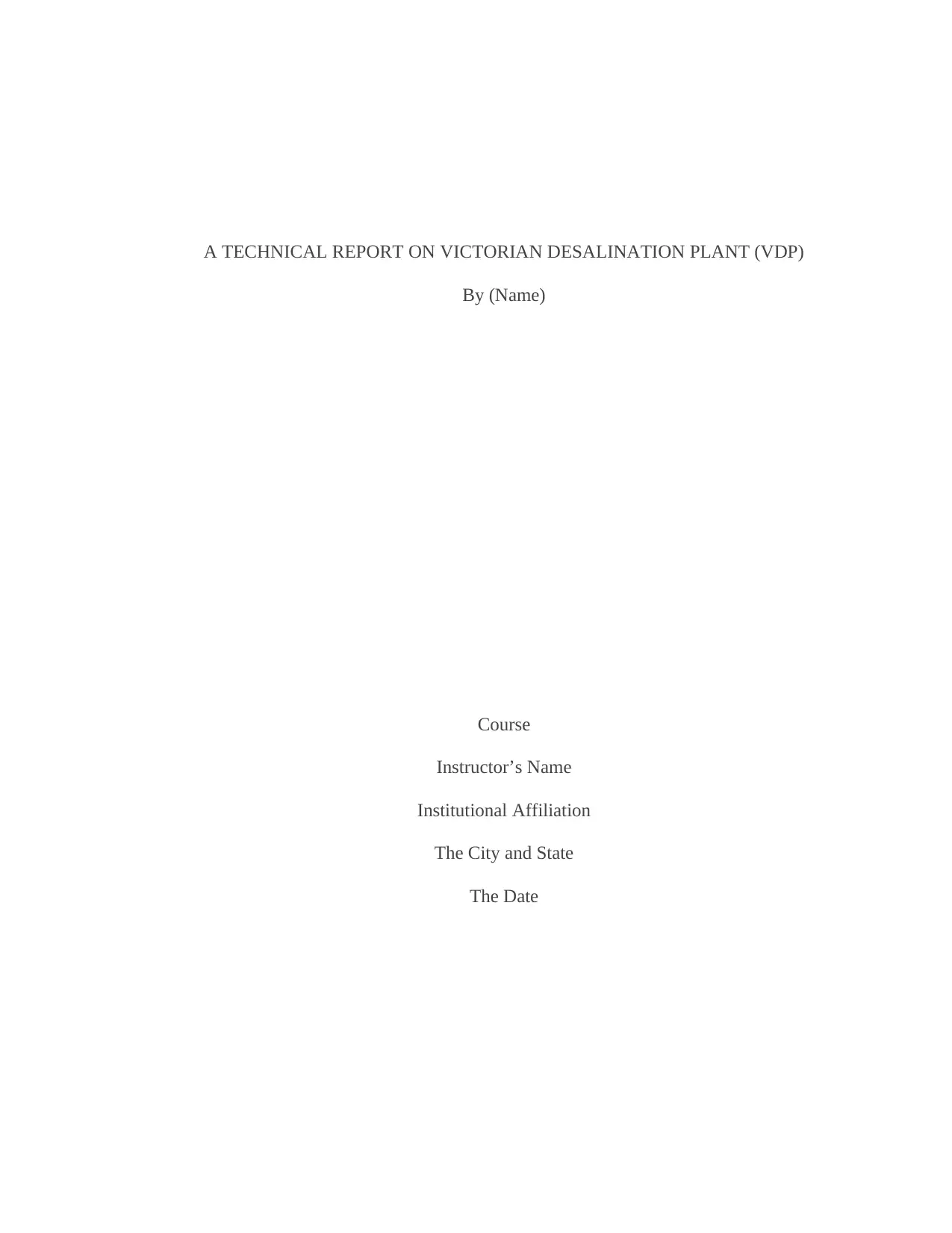
A TECHNICAL REPORT ON VICTORIAN DESALINATION PLANT (VDP)
By (Name)
Course
Instructor’s Name
Institutional Affiliation
The City and State
The Date
By (Name)
Course
Instructor’s Name
Institutional Affiliation
The City and State
The Date
Paraphrase This Document
Need a fresh take? Get an instant paraphrase of this document with our AI Paraphraser
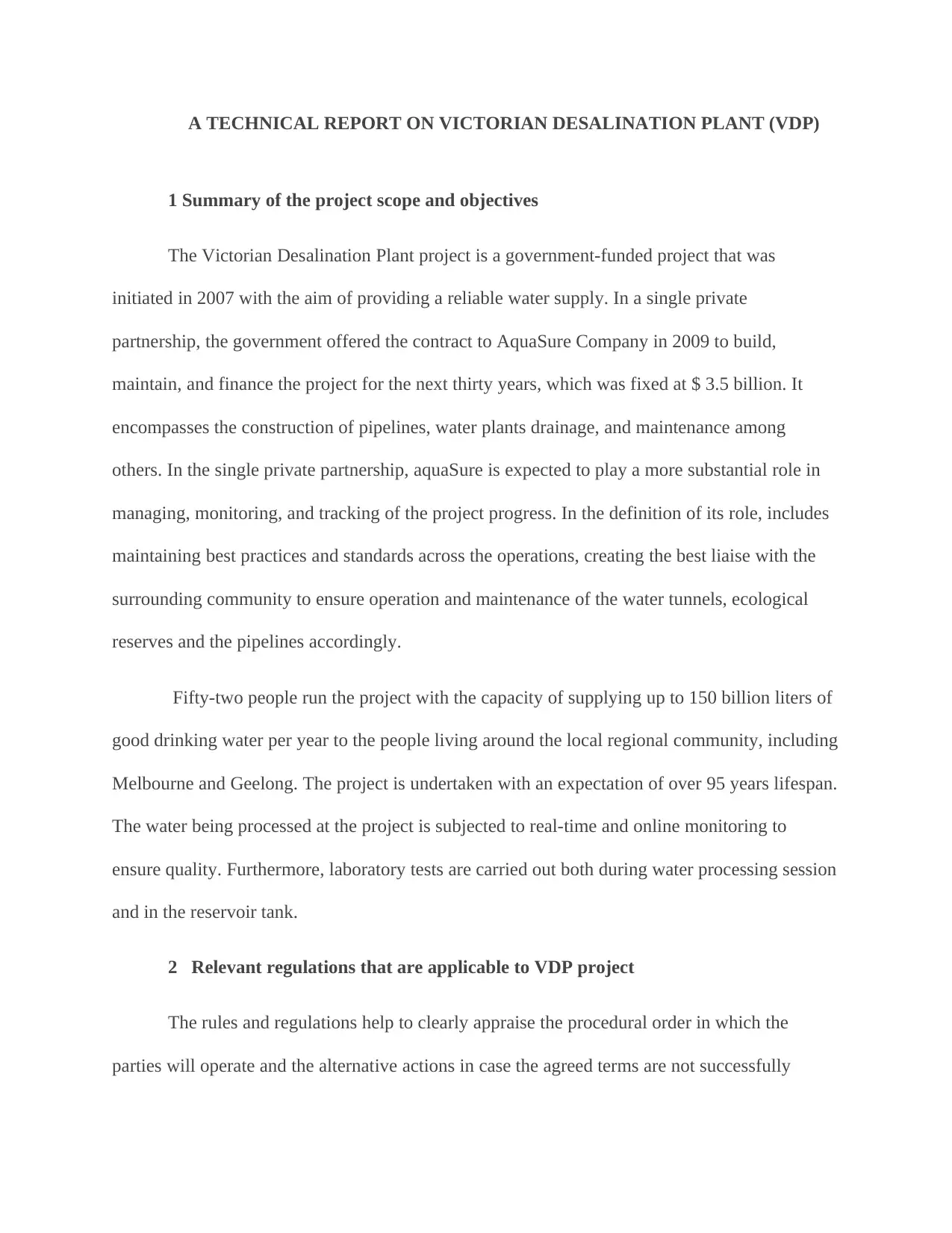
A TECHNICAL REPORT ON VICTORIAN DESALINATION PLANT (VDP)
1 Summary of the project scope and objectives
The Victorian Desalination Plant project is a government-funded project that was
initiated in 2007 with the aim of providing a reliable water supply. In a single private
partnership, the government offered the contract to AquaSure Company in 2009 to build,
maintain, and finance the project for the next thirty years, which was fixed at $ 3.5 billion. It
encompasses the construction of pipelines, water plants drainage, and maintenance among
others. In the single private partnership, aquaSure is expected to play a more substantial role in
managing, monitoring, and tracking of the project progress. In the definition of its role, includes
maintaining best practices and standards across the operations, creating the best liaise with the
surrounding community to ensure operation and maintenance of the water tunnels, ecological
reserves and the pipelines accordingly.
Fifty-two people run the project with the capacity of supplying up to 150 billion liters of
good drinking water per year to the people living around the local regional community, including
Melbourne and Geelong. The project is undertaken with an expectation of over 95 years lifespan.
The water being processed at the project is subjected to real-time and online monitoring to
ensure quality. Furthermore, laboratory tests are carried out both during water processing session
and in the reservoir tank.
2 Relevant regulations that are applicable to VDP project
The rules and regulations help to clearly appraise the procedural order in which the
parties will operate and the alternative actions in case the agreed terms are not successfully
1 Summary of the project scope and objectives
The Victorian Desalination Plant project is a government-funded project that was
initiated in 2007 with the aim of providing a reliable water supply. In a single private
partnership, the government offered the contract to AquaSure Company in 2009 to build,
maintain, and finance the project for the next thirty years, which was fixed at $ 3.5 billion. It
encompasses the construction of pipelines, water plants drainage, and maintenance among
others. In the single private partnership, aquaSure is expected to play a more substantial role in
managing, monitoring, and tracking of the project progress. In the definition of its role, includes
maintaining best practices and standards across the operations, creating the best liaise with the
surrounding community to ensure operation and maintenance of the water tunnels, ecological
reserves and the pipelines accordingly.
Fifty-two people run the project with the capacity of supplying up to 150 billion liters of
good drinking water per year to the people living around the local regional community, including
Melbourne and Geelong. The project is undertaken with an expectation of over 95 years lifespan.
The water being processed at the project is subjected to real-time and online monitoring to
ensure quality. Furthermore, laboratory tests are carried out both during water processing session
and in the reservoir tank.
2 Relevant regulations that are applicable to VDP project
The rules and regulations help to clearly appraise the procedural order in which the
parties will operate and the alternative actions in case the agreed terms are not successfully
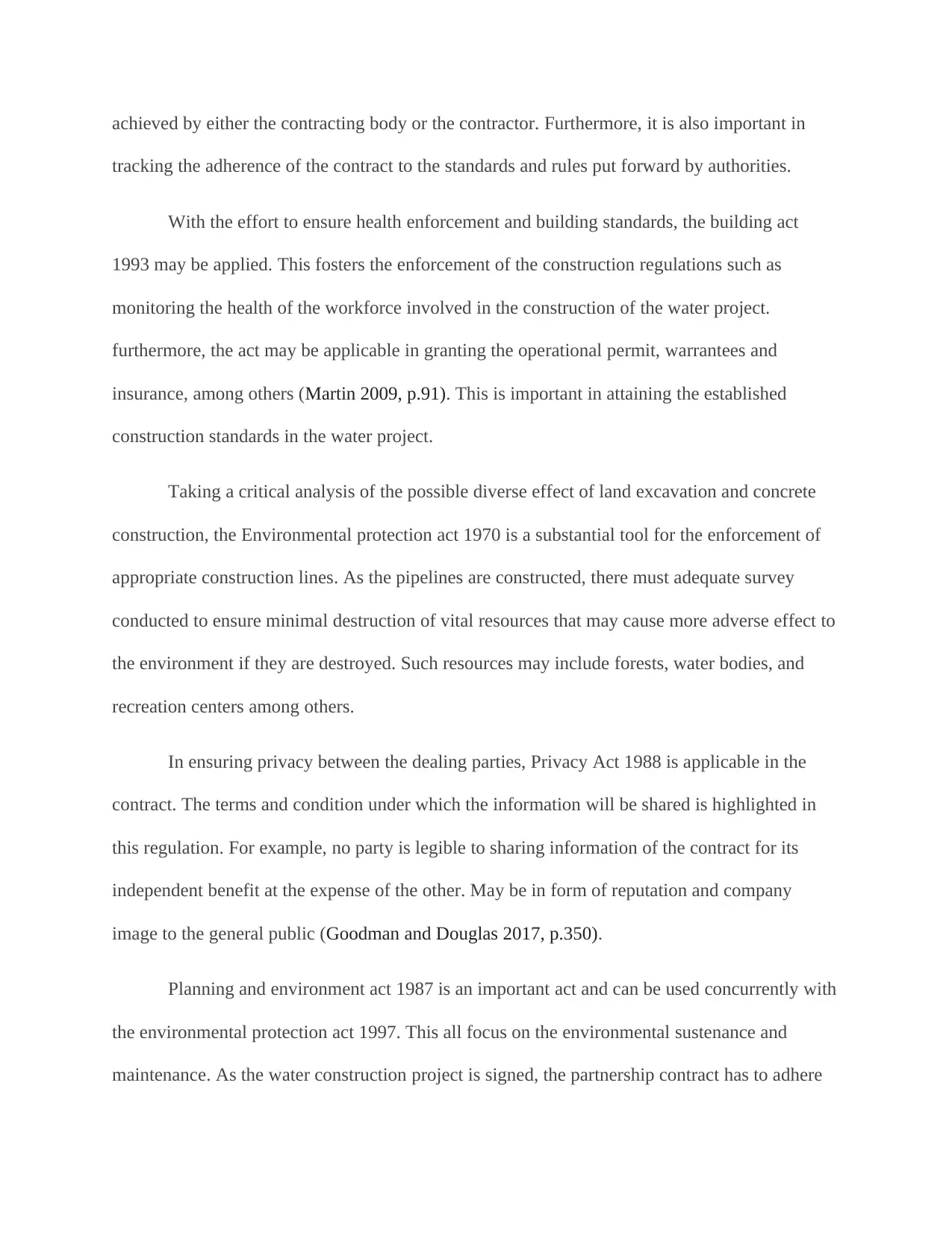
achieved by either the contracting body or the contractor. Furthermore, it is also important in
tracking the adherence of the contract to the standards and rules put forward by authorities.
With the effort to ensure health enforcement and building standards, the building act
1993 may be applied. This fosters the enforcement of the construction regulations such as
monitoring the health of the workforce involved in the construction of the water project.
furthermore, the act may be applicable in granting the operational permit, warrantees and
insurance, among others (Martin 2009, p.91). This is important in attaining the established
construction standards in the water project.
Taking a critical analysis of the possible diverse effect of land excavation and concrete
construction, the Environmental protection act 1970 is a substantial tool for the enforcement of
appropriate construction lines. As the pipelines are constructed, there must adequate survey
conducted to ensure minimal destruction of vital resources that may cause more adverse effect to
the environment if they are destroyed. Such resources may include forests, water bodies, and
recreation centers among others.
In ensuring privacy between the dealing parties, Privacy Act 1988 is applicable in the
contract. The terms and condition under which the information will be shared is highlighted in
this regulation. For example, no party is legible to sharing information of the contract for its
independent benefit at the expense of the other. May be in form of reputation and company
image to the general public (Goodman and Douglas 2017, p.350).
Planning and environment act 1987 is an important act and can be used concurrently with
the environmental protection act 1997. This all focus on the environmental sustenance and
maintenance. As the water construction project is signed, the partnership contract has to adhere
tracking the adherence of the contract to the standards and rules put forward by authorities.
With the effort to ensure health enforcement and building standards, the building act
1993 may be applied. This fosters the enforcement of the construction regulations such as
monitoring the health of the workforce involved in the construction of the water project.
furthermore, the act may be applicable in granting the operational permit, warrantees and
insurance, among others (Martin 2009, p.91). This is important in attaining the established
construction standards in the water project.
Taking a critical analysis of the possible diverse effect of land excavation and concrete
construction, the Environmental protection act 1970 is a substantial tool for the enforcement of
appropriate construction lines. As the pipelines are constructed, there must adequate survey
conducted to ensure minimal destruction of vital resources that may cause more adverse effect to
the environment if they are destroyed. Such resources may include forests, water bodies, and
recreation centers among others.
In ensuring privacy between the dealing parties, Privacy Act 1988 is applicable in the
contract. The terms and condition under which the information will be shared is highlighted in
this regulation. For example, no party is legible to sharing information of the contract for its
independent benefit at the expense of the other. May be in form of reputation and company
image to the general public (Goodman and Douglas 2017, p.350).
Planning and environment act 1987 is an important act and can be used concurrently with
the environmental protection act 1997. This all focus on the environmental sustenance and
maintenance. As the water construction project is signed, the partnership contract has to adhere
⊘ This is a preview!⊘
Do you want full access?
Subscribe today to unlock all pages.

Trusted by 1+ million students worldwide
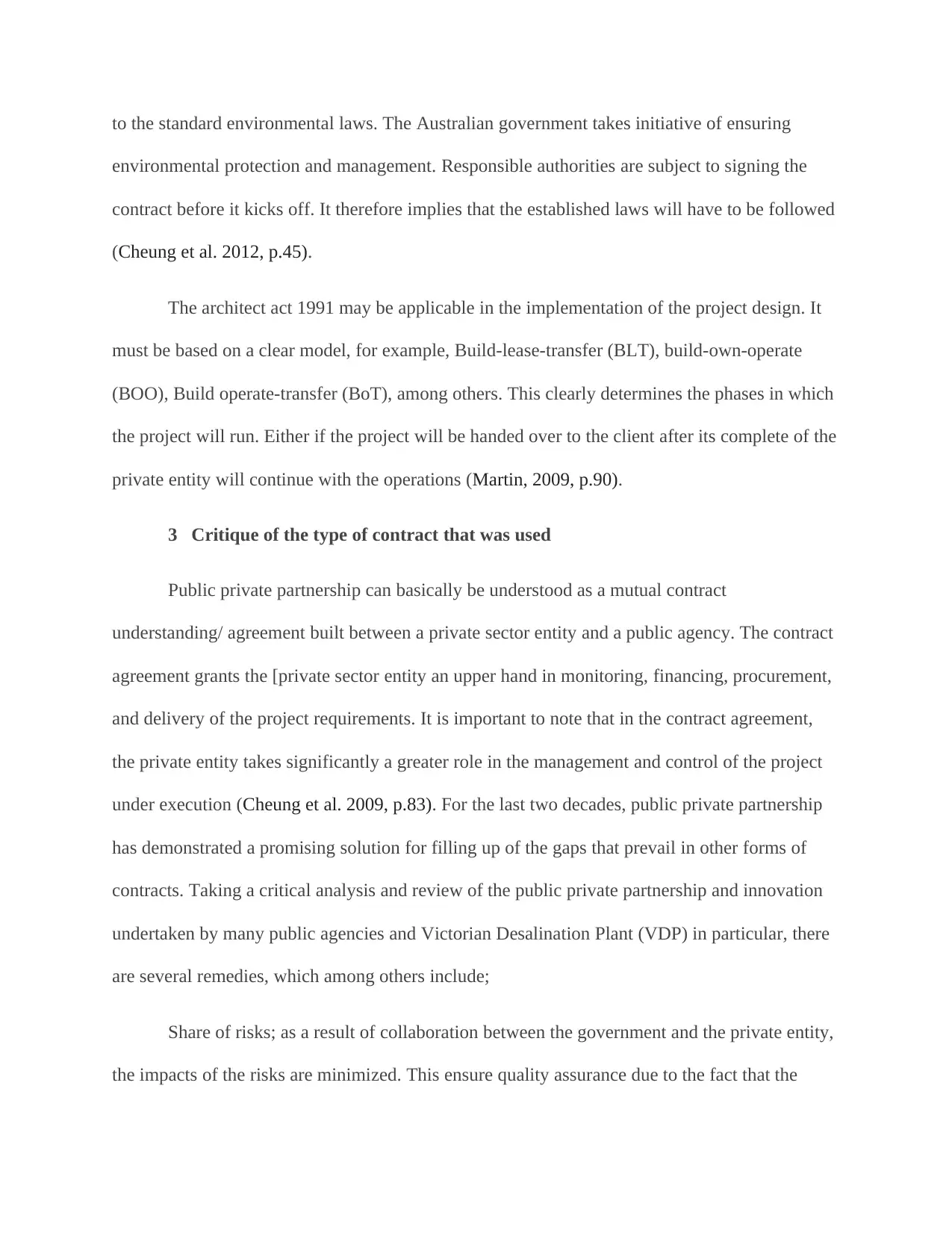
to the standard environmental laws. The Australian government takes initiative of ensuring
environmental protection and management. Responsible authorities are subject to signing the
contract before it kicks off. It therefore implies that the established laws will have to be followed
(Cheung et al. 2012, p.45).
The architect act 1991 may be applicable in the implementation of the project design. It
must be based on a clear model, for example, Build-lease-transfer (BLT), build-own-operate
(BOO), Build operate-transfer (BoT), among others. This clearly determines the phases in which
the project will run. Either if the project will be handed over to the client after its complete of the
private entity will continue with the operations (Martin, 2009, p.90).
3 Critique of the type of contract that was used
Public private partnership can basically be understood as a mutual contract
understanding/ agreement built between a private sector entity and a public agency. The contract
agreement grants the [private sector entity an upper hand in monitoring, financing, procurement,
and delivery of the project requirements. It is important to note that in the contract agreement,
the private entity takes significantly a greater role in the management and control of the project
under execution (Cheung et al. 2009, p.83). For the last two decades, public private partnership
has demonstrated a promising solution for filling up of the gaps that prevail in other forms of
contracts. Taking a critical analysis and review of the public private partnership and innovation
undertaken by many public agencies and Victorian Desalination Plant (VDP) in particular, there
are several remedies, which among others include;
Share of risks; as a result of collaboration between the government and the private entity,
the impacts of the risks are minimized. This ensure quality assurance due to the fact that the
environmental protection and management. Responsible authorities are subject to signing the
contract before it kicks off. It therefore implies that the established laws will have to be followed
(Cheung et al. 2012, p.45).
The architect act 1991 may be applicable in the implementation of the project design. It
must be based on a clear model, for example, Build-lease-transfer (BLT), build-own-operate
(BOO), Build operate-transfer (BoT), among others. This clearly determines the phases in which
the project will run. Either if the project will be handed over to the client after its complete of the
private entity will continue with the operations (Martin, 2009, p.90).
3 Critique of the type of contract that was used
Public private partnership can basically be understood as a mutual contract
understanding/ agreement built between a private sector entity and a public agency. The contract
agreement grants the [private sector entity an upper hand in monitoring, financing, procurement,
and delivery of the project requirements. It is important to note that in the contract agreement,
the private entity takes significantly a greater role in the management and control of the project
under execution (Cheung et al. 2009, p.83). For the last two decades, public private partnership
has demonstrated a promising solution for filling up of the gaps that prevail in other forms of
contracts. Taking a critical analysis and review of the public private partnership and innovation
undertaken by many public agencies and Victorian Desalination Plant (VDP) in particular, there
are several remedies, which among others include;
Share of risks; as a result of collaboration between the government and the private entity,
the impacts of the risks are minimized. This ensure quality assurance due to the fact that the
Paraphrase This Document
Need a fresh take? Get an instant paraphrase of this document with our AI Paraphraser
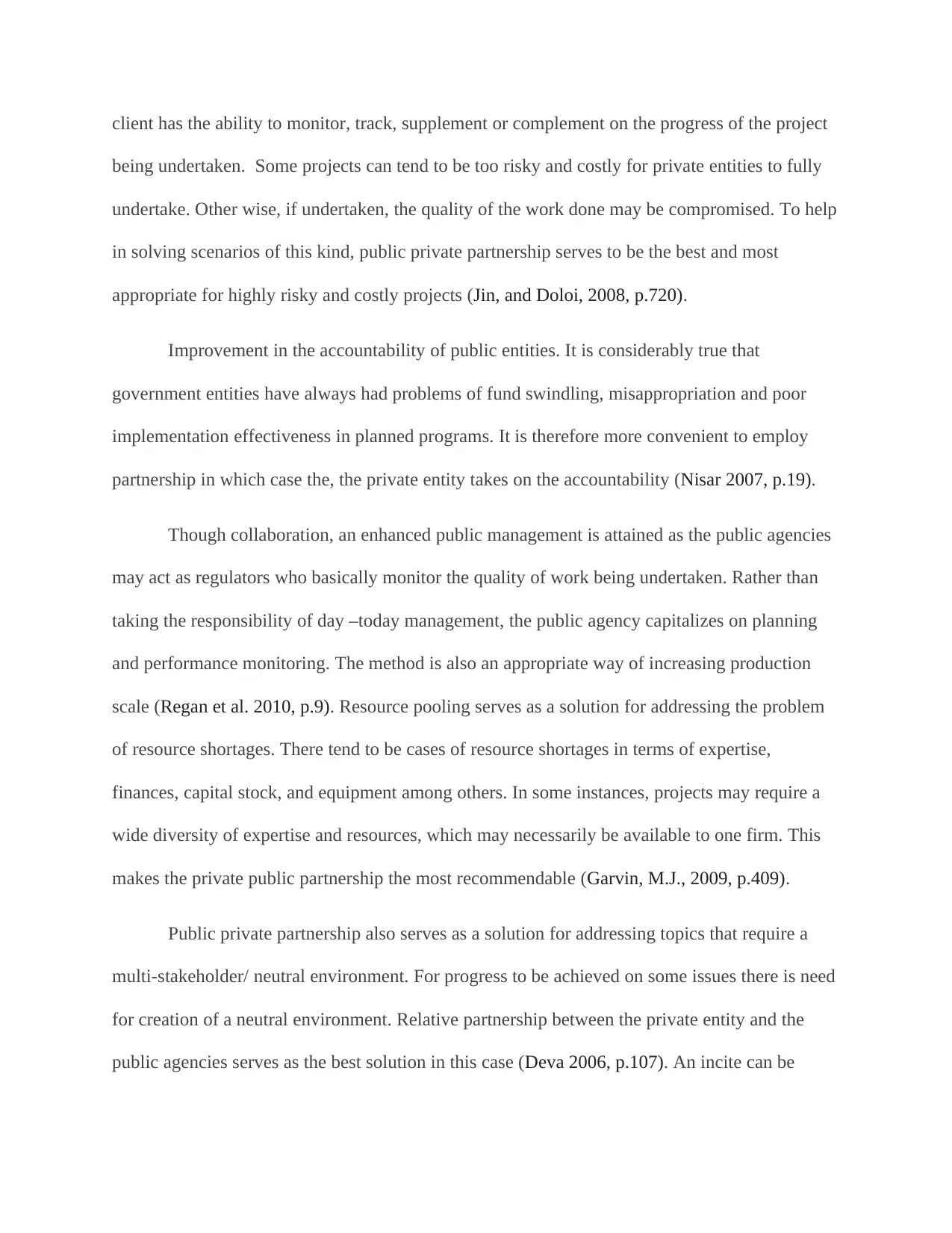
client has the ability to monitor, track, supplement or complement on the progress of the project
being undertaken. Some projects can tend to be too risky and costly for private entities to fully
undertake. Other wise, if undertaken, the quality of the work done may be compromised. To help
in solving scenarios of this kind, public private partnership serves to be the best and most
appropriate for highly risky and costly projects (Jin, and Doloi, 2008, p.720).
Improvement in the accountability of public entities. It is considerably true that
government entities have always had problems of fund swindling, misappropriation and poor
implementation effectiveness in planned programs. It is therefore more convenient to employ
partnership in which case the, the private entity takes on the accountability (Nisar 2007, p.19).
Though collaboration, an enhanced public management is attained as the public agencies
may act as regulators who basically monitor the quality of work being undertaken. Rather than
taking the responsibility of day –today management, the public agency capitalizes on planning
and performance monitoring. The method is also an appropriate way of increasing production
scale (Regan et al. 2010, p.9). Resource pooling serves as a solution for addressing the problem
of resource shortages. There tend to be cases of resource shortages in terms of expertise,
finances, capital stock, and equipment among others. In some instances, projects may require a
wide diversity of expertise and resources, which may necessarily be available to one firm. This
makes the private public partnership the most recommendable (Garvin, M.J., 2009, p.409).
Public private partnership also serves as a solution for addressing topics that require a
multi-stakeholder/ neutral environment. For progress to be achieved on some issues there is need
for creation of a neutral environment. Relative partnership between the private entity and the
public agencies serves as the best solution in this case (Deva 2006, p.107). An incite can be
being undertaken. Some projects can tend to be too risky and costly for private entities to fully
undertake. Other wise, if undertaken, the quality of the work done may be compromised. To help
in solving scenarios of this kind, public private partnership serves to be the best and most
appropriate for highly risky and costly projects (Jin, and Doloi, 2008, p.720).
Improvement in the accountability of public entities. It is considerably true that
government entities have always had problems of fund swindling, misappropriation and poor
implementation effectiveness in planned programs. It is therefore more convenient to employ
partnership in which case the, the private entity takes on the accountability (Nisar 2007, p.19).
Though collaboration, an enhanced public management is attained as the public agencies
may act as regulators who basically monitor the quality of work being undertaken. Rather than
taking the responsibility of day –today management, the public agency capitalizes on planning
and performance monitoring. The method is also an appropriate way of increasing production
scale (Regan et al. 2010, p.9). Resource pooling serves as a solution for addressing the problem
of resource shortages. There tend to be cases of resource shortages in terms of expertise,
finances, capital stock, and equipment among others. In some instances, projects may require a
wide diversity of expertise and resources, which may necessarily be available to one firm. This
makes the private public partnership the most recommendable (Garvin, M.J., 2009, p.409).
Public private partnership also serves as a solution for addressing topics that require a
multi-stakeholder/ neutral environment. For progress to be achieved on some issues there is need
for creation of a neutral environment. Relative partnership between the private entity and the
public agencies serves as the best solution in this case (Deva 2006, p.107). An incite can be
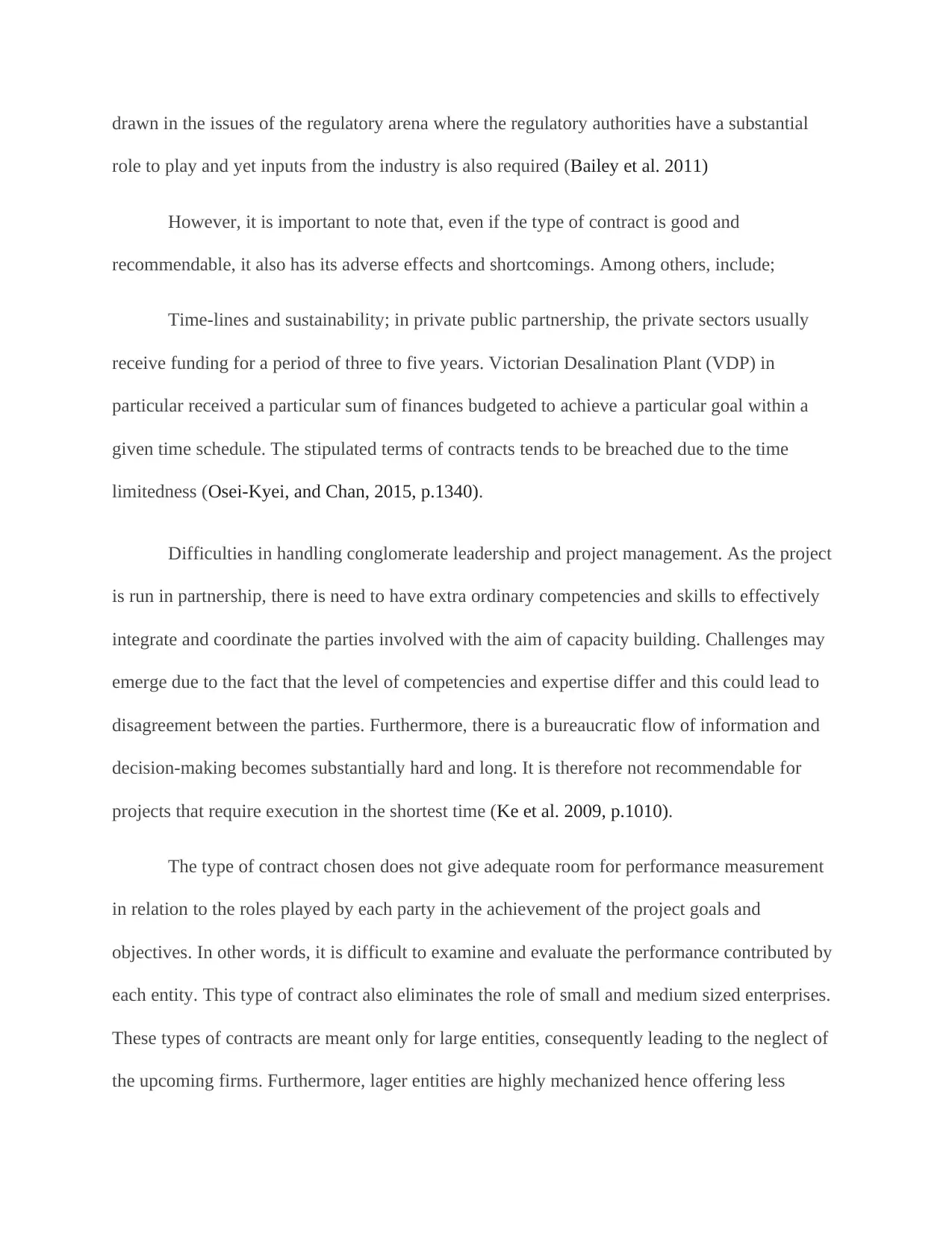
drawn in the issues of the regulatory arena where the regulatory authorities have a substantial
role to play and yet inputs from the industry is also required (Bailey et al. 2011)
However, it is important to note that, even if the type of contract is good and
recommendable, it also has its adverse effects and shortcomings. Among others, include;
Time-lines and sustainability; in private public partnership, the private sectors usually
receive funding for a period of three to five years. Victorian Desalination Plant (VDP) in
particular received a particular sum of finances budgeted to achieve a particular goal within a
given time schedule. The stipulated terms of contracts tends to be breached due to the time
limitedness (Osei-Kyei, and Chan, 2015, p.1340).
Difficulties in handling conglomerate leadership and project management. As the project
is run in partnership, there is need to have extra ordinary competencies and skills to effectively
integrate and coordinate the parties involved with the aim of capacity building. Challenges may
emerge due to the fact that the level of competencies and expertise differ and this could lead to
disagreement between the parties. Furthermore, there is a bureaucratic flow of information and
decision-making becomes substantially hard and long. It is therefore not recommendable for
projects that require execution in the shortest time (Ke et al. 2009, p.1010).
The type of contract chosen does not give adequate room for performance measurement
in relation to the roles played by each party in the achievement of the project goals and
objectives. In other words, it is difficult to examine and evaluate the performance contributed by
each entity. This type of contract also eliminates the role of small and medium sized enterprises.
These types of contracts are meant only for large entities, consequently leading to the neglect of
the upcoming firms. Furthermore, lager entities are highly mechanized hence offering less
role to play and yet inputs from the industry is also required (Bailey et al. 2011)
However, it is important to note that, even if the type of contract is good and
recommendable, it also has its adverse effects and shortcomings. Among others, include;
Time-lines and sustainability; in private public partnership, the private sectors usually
receive funding for a period of three to five years. Victorian Desalination Plant (VDP) in
particular received a particular sum of finances budgeted to achieve a particular goal within a
given time schedule. The stipulated terms of contracts tends to be breached due to the time
limitedness (Osei-Kyei, and Chan, 2015, p.1340).
Difficulties in handling conglomerate leadership and project management. As the project
is run in partnership, there is need to have extra ordinary competencies and skills to effectively
integrate and coordinate the parties involved with the aim of capacity building. Challenges may
emerge due to the fact that the level of competencies and expertise differ and this could lead to
disagreement between the parties. Furthermore, there is a bureaucratic flow of information and
decision-making becomes substantially hard and long. It is therefore not recommendable for
projects that require execution in the shortest time (Ke et al. 2009, p.1010).
The type of contract chosen does not give adequate room for performance measurement
in relation to the roles played by each party in the achievement of the project goals and
objectives. In other words, it is difficult to examine and evaluate the performance contributed by
each entity. This type of contract also eliminates the role of small and medium sized enterprises.
These types of contracts are meant only for large entities, consequently leading to the neglect of
the upcoming firms. Furthermore, lager entities are highly mechanized hence offering less
⊘ This is a preview!⊘
Do you want full access?
Subscribe today to unlock all pages.

Trusted by 1+ million students worldwide
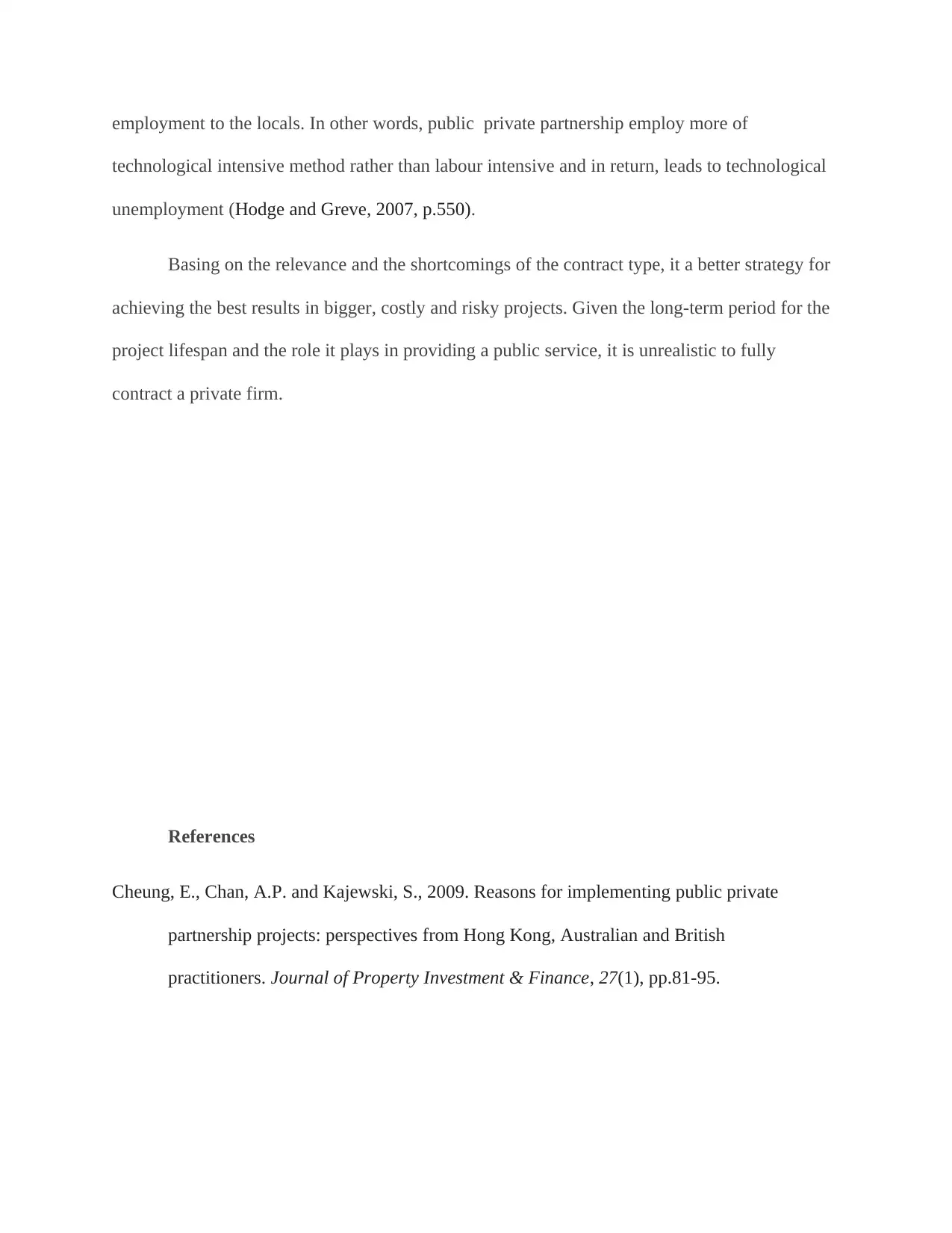
employment to the locals. In other words, public private partnership employ more of
technological intensive method rather than labour intensive and in return, leads to technological
unemployment (Hodge and Greve, 2007, p.550).
Basing on the relevance and the shortcomings of the contract type, it a better strategy for
achieving the best results in bigger, costly and risky projects. Given the long-term period for the
project lifespan and the role it plays in providing a public service, it is unrealistic to fully
contract a private firm.
References
Cheung, E., Chan, A.P. and Kajewski, S., 2009. Reasons for implementing public private
partnership projects: perspectives from Hong Kong, Australian and British
practitioners. Journal of Property Investment & Finance, 27(1), pp.81-95.
technological intensive method rather than labour intensive and in return, leads to technological
unemployment (Hodge and Greve, 2007, p.550).
Basing on the relevance and the shortcomings of the contract type, it a better strategy for
achieving the best results in bigger, costly and risky projects. Given the long-term period for the
project lifespan and the role it plays in providing a public service, it is unrealistic to fully
contract a private firm.
References
Cheung, E., Chan, A.P. and Kajewski, S., 2009. Reasons for implementing public private
partnership projects: perspectives from Hong Kong, Australian and British
practitioners. Journal of Property Investment & Finance, 27(1), pp.81-95.
Paraphrase This Document
Need a fresh take? Get an instant paraphrase of this document with our AI Paraphraser
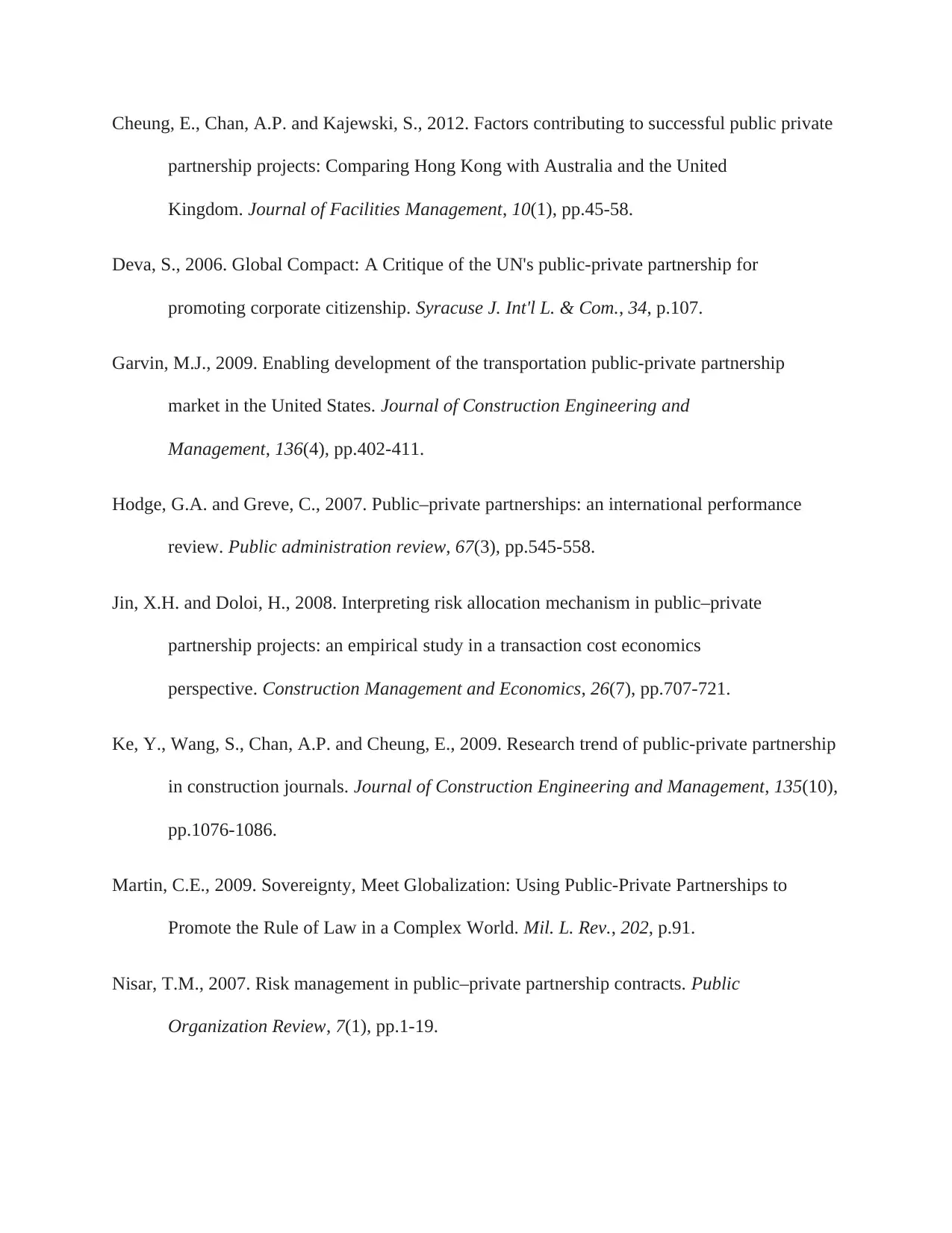
Cheung, E., Chan, A.P. and Kajewski, S., 2012. Factors contributing to successful public private
partnership projects: Comparing Hong Kong with Australia and the United
Kingdom. Journal of Facilities Management, 10(1), pp.45-58.
Deva, S., 2006. Global Compact: A Critique of the UN's public-private partnership for
promoting corporate citizenship. Syracuse J. Int'l L. & Com., 34, p.107.
Garvin, M.J., 2009. Enabling development of the transportation public-private partnership
market in the United States. Journal of Construction Engineering and
Management, 136(4), pp.402-411.
Hodge, G.A. and Greve, C., 2007. Public–private partnerships: an international performance
review. Public administration review, 67(3), pp.545-558.
Jin, X.H. and Doloi, H., 2008. Interpreting risk allocation mechanism in public–private
partnership projects: an empirical study in a transaction cost economics
perspective. Construction Management and Economics, 26(7), pp.707-721.
Ke, Y., Wang, S., Chan, A.P. and Cheung, E., 2009. Research trend of public-private partnership
in construction journals. Journal of Construction Engineering and Management, 135(10),
pp.1076-1086.
Martin, C.E., 2009. Sovereignty, Meet Globalization: Using Public-Private Partnerships to
Promote the Rule of Law in a Complex World. Mil. L. Rev., 202, p.91.
Nisar, T.M., 2007. Risk management in public–private partnership contracts. Public
Organization Review, 7(1), pp.1-19.
partnership projects: Comparing Hong Kong with Australia and the United
Kingdom. Journal of Facilities Management, 10(1), pp.45-58.
Deva, S., 2006. Global Compact: A Critique of the UN's public-private partnership for
promoting corporate citizenship. Syracuse J. Int'l L. & Com., 34, p.107.
Garvin, M.J., 2009. Enabling development of the transportation public-private partnership
market in the United States. Journal of Construction Engineering and
Management, 136(4), pp.402-411.
Hodge, G.A. and Greve, C., 2007. Public–private partnerships: an international performance
review. Public administration review, 67(3), pp.545-558.
Jin, X.H. and Doloi, H., 2008. Interpreting risk allocation mechanism in public–private
partnership projects: an empirical study in a transaction cost economics
perspective. Construction Management and Economics, 26(7), pp.707-721.
Ke, Y., Wang, S., Chan, A.P. and Cheung, E., 2009. Research trend of public-private partnership
in construction journals. Journal of Construction Engineering and Management, 135(10),
pp.1076-1086.
Martin, C.E., 2009. Sovereignty, Meet Globalization: Using Public-Private Partnerships to
Promote the Rule of Law in a Complex World. Mil. L. Rev., 202, p.91.
Nisar, T.M., 2007. Risk management in public–private partnership contracts. Public
Organization Review, 7(1), pp.1-19.
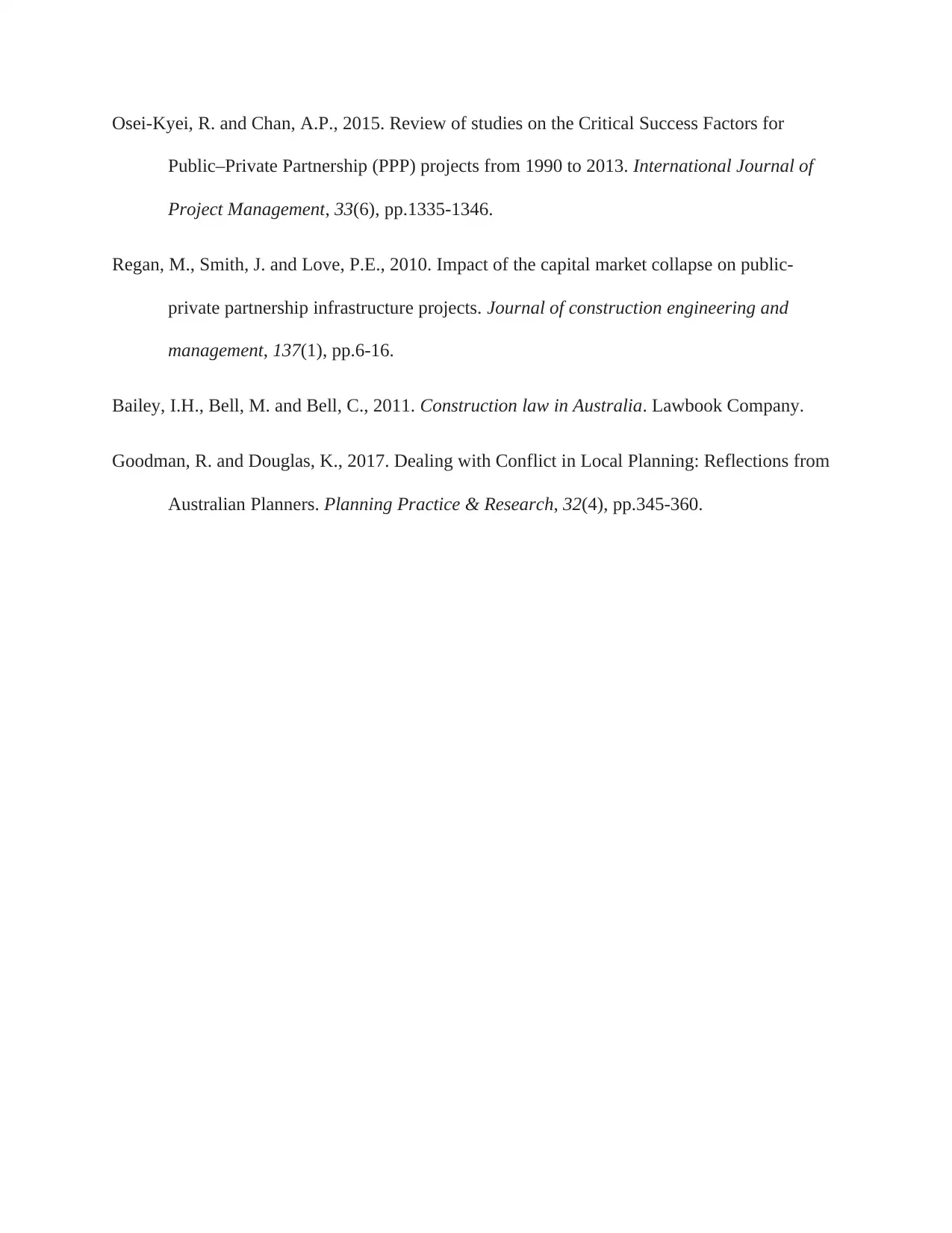
Osei-Kyei, R. and Chan, A.P., 2015. Review of studies on the Critical Success Factors for
Public–Private Partnership (PPP) projects from 1990 to 2013. International Journal of
Project Management, 33(6), pp.1335-1346.
Regan, M., Smith, J. and Love, P.E., 2010. Impact of the capital market collapse on public-
private partnership infrastructure projects. Journal of construction engineering and
management, 137(1), pp.6-16.
Bailey, I.H., Bell, M. and Bell, C., 2011. Construction law in Australia. Lawbook Company.
Goodman, R. and Douglas, K., 2017. Dealing with Conflict in Local Planning: Reflections from
Australian Planners. Planning Practice & Research, 32(4), pp.345-360.
Public–Private Partnership (PPP) projects from 1990 to 2013. International Journal of
Project Management, 33(6), pp.1335-1346.
Regan, M., Smith, J. and Love, P.E., 2010. Impact of the capital market collapse on public-
private partnership infrastructure projects. Journal of construction engineering and
management, 137(1), pp.6-16.
Bailey, I.H., Bell, M. and Bell, C., 2011. Construction law in Australia. Lawbook Company.
Goodman, R. and Douglas, K., 2017. Dealing with Conflict in Local Planning: Reflections from
Australian Planners. Planning Practice & Research, 32(4), pp.345-360.
⊘ This is a preview!⊘
Do you want full access?
Subscribe today to unlock all pages.

Trusted by 1+ million students worldwide
1 out of 9
Related Documents
Your All-in-One AI-Powered Toolkit for Academic Success.
+13062052269
info@desklib.com
Available 24*7 on WhatsApp / Email
![[object Object]](/_next/static/media/star-bottom.7253800d.svg)
Unlock your academic potential
Copyright © 2020–2025 A2Z Services. All Rights Reserved. Developed and managed by ZUCOL.



